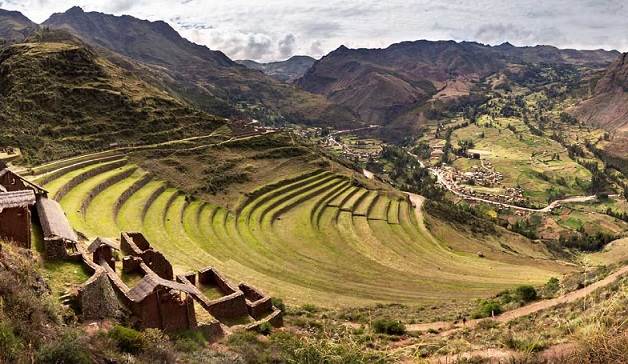The Sacred Valley was the spiritual home of the mighty Inca Empire. Legend has it that they wandered the Andes from their origins near Lake Titicaca until arriving at the Urubamba Valley, instantly recognising its profound, spiritual beauty and immediately claiming it as their new home land. Take a few days to explore the Valley and its surroundings, you’ll soon understand its central position within the Inca worldview.
Pisac & Pisac Ruins
You’ll get your first glimpse of the Inca’s intricate farming terraces and water irrigation system at the ruins of Pisac, which are about an hour’s drive away from the city of Cusco. Like many Incan ruins, Pisac is strategically positioned atop a mountain, which made it ideal location to carry out religious ceremonies and scout intruders. Make a stop in the town of Pisac on a Sunday, Tuesday, or Thursday to shop at the regional market, where you’ll be able to buy inexpensive fruits, vegetables, handicrafts, and souvenirs.
Ollantaytambo
The most impressive stop on any tour of the Sacred Valley is undoubtedly Ollantaytambo, located just a few hours by train from Aguas Calientes and Machu Picchu. This ancient village has been continually inhabited since the 13th century, and its well-preserved architecture provides an immediate connection with the days of the Inca.
The town has been noted as the best surviving example of Incan town planning, known for its canchas (blocks), which consist of a single entrance, a central courtyard, and simple dwellings bordering the courtyard. The ancient Incan terraces, fountains, and storehouses provide a stunning backdrop to this small town, as well as a glimpse into the remarkable architectural styles and agricultural practices of the Incas who once lived there.
Moras and Moray
An excursion to Moray will provide you with a different perspective on Incan agricultural practices. The Incas used the circular depressions that distinguish Moray to experiment with new crops at different temperatures and altitudes, since the chilly highland temperatures and stubborn Andean terrain are not always well-suited for crop-growing. Be sure to dress in layers for a visit to Moray: a T-Shirt may suffice on the top terrace, but you’ll want to have a sweater handy by the time you reach the final terrace.
Next, visit the nearby salt ponds of Maras. The salty water that comprises these ponds emerges at a thermal spring and eventually filters into several hundred terraced ponds. These natural salt deposits have been harvested since pre-Inca times, and are still mined by locals in the region today.
Urubamba River Rafting
Take a break from your visits to the ruins of the Sacred Valley and enjoy the local scenery on a white water rafting adventure. Arrange a one or two day tour on the Urubamba River to paddle your way down class II through IV rapids, depending on your skill level. Along the way, you’ll have a great view of the local flora – flowers, cactuses, and eucalyptus trees.
Chinchero
According to legend, the small Andean village of Chichero was the birthplace of the rainbow. Tupac Inca Yupanqui also had an estate there during his rule, and it’s easy to see why: from Chinchero, you’ll be able to take in stunning mountainside views. However, the most celebrated Chinchero attraction – the cathedral – is of Spanish origin; it is uniquely decorated with bright colors and floral patterns. The town also holds a small market on Sundays, where you can pick up one of its famous Andean textiles.
A note about the Boleto Turistico (Tourist Ticket)
You’ll need the purchase the boleto turístico to gain admission to most of the sites on this list – Chinchero, Pisac, and Ollantaytambo. The ticket costs S/. 130 (about $50 USD) and is valid for 10 days. The ticket includes admission to 13 other sites in Cusco and the Sacred Valley. This cost is included in all Worldwide Adventures but not Adventures for 20s and 30s.



